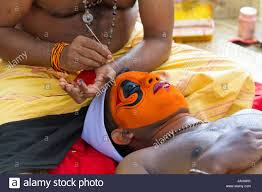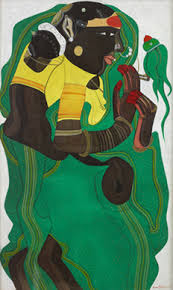The start with 'Gulikan'
I was at the fag-end of my
studies and the final-sem exams were just over. The year was 1980. Instead of
going home and wait for the results, I had this idea of hanging around for some
more time. My class-mate and good friend R.Panikker too had similar inclination.
We landed up at a place called ‘Palayad’ near Thalasseri and started teaching
engineering subjects in an Industrial Training Institute.
Our students were a score odd
teenagers, the sons of beedi-rollers of the humble village which had nothing to
boast except greenery and warmth. The beedi-workers formed a mother co-operative
society with its satellite-centres all over North Malabar and
professionally managed its production and marketing.
The Industrial Training Centre
was a house located at the backyard of the one-room & hall ‘factory’ of the
local ‘Dinesh Beedi’ workers. The interesting thing about the place was that no
house or institution had compound walls. Anybody could walk around though
anywhere. Our accommodation was provided at the ITC itself where we had a
furnished bed-room, a cot, mattress and a lone stool at our disposal. Food too
was arranged with our neighbour at a stone’s-throw, a family who made a living
by supplying tea and snacks to the beedi-workers.
Beedi-rollers, both men and
women, worked there from morning till evening listening to songs from radio.
However, newspaper was their prime concern and arrangements were made for
reading it aloud. One of their colleagues would be reading out the newspaper
while others aptly listened. The newsreader was exempted from work as
compensation. Every bit of news was analysed, including the international ones,
and a definite stand was taken. In rare cases of disagreement, seniors took the
lead and consensus was reached on all major issues. The beedis were being
rolled out at a constant pace amidst music, news and analysis. We were total
strangers in this setting as if almost air-dropped into the scene. The
beedi-rollers received us like honourable guests. They asked us questions which
were not even remotely connected to their lives. For them, we were very learned
men authorised to give the final word.
Panikker and I shared a
fascination for ‘Theyyams” which is the spoken form of ‘Daivam’ meaning God in
Malayalam. More than the religious content, there were stories in circulation
that ‘Theyyams’ were the reincarnation of martyrs killed cruelly by the rulers
or upper caste landlords. When the underdogs were being witch-hunted by the
feudal-lords, either for the downtrodden land or for their women, some who had
the nerve stood up at the risk of being counted. Invariably they were
persecuted in most heinous ways. Their peers and the common folk in general
watched the killings helplessly. They were too scared to point even an accusing
finger at the elite. As time went by the sacrifice was honoured by later
generations. The victims descended to earth as their souls were invoked by the
villagers through ‘Theyyam’. God is believed to enter the body of the performer
and hence believers consider him as a visible manifestation of God. This aspect
fascinated us in particular. The time was also ripe, as the Theyyam season
starts in November and lasts through April.
 |
| makeup of Gulikan Thottam in progress |
We came to understand that God’s
were also represented directly by certain Theyyams and they too were popular! The
Theyyams were performed in sacred groves, village shrines and Namboothiri
illoms (Brahmin households of Kerala). Naturally lower caste martyrs were
unwelcome in such places. Besides, there were Islams Theyyams too which also had
a story of treachery and persecution behind them. Theyyams
like Ummachi, Mappla Chamundi, Mukri etc. with a similar history leading to
their untimely death. Both Hindus and
Muslims celebrate Theyyams and nobody is barred in the Theyyam arena on any
count. Theyyams are said to be 1500 years old.
The number of Theyyams is
estimated to be 453 out of which 120 of them are quite popular. They dance to
remove the evil from the world. You can approach Him/Her with your personal
problems too and they prescribe remedies per se.
Theyyam begins with an invocation
called ‘Thottam pattu’ which gives the
life-line of the particular
Theyyam. Prior to that, the Theyyam performer starts putting on his elaborate
make-up after undergoing rigorous ‘vrat’ (steadfast spiritual and physical
exercises, diet restrictions, fasting etc.). It takes eight to ten hours for completing the
make-up.
 |
| The Gulikan thottam singer after makeup |
The Theyyam players are always ingenious
tribal communities like Vannan, Malayan, Velan etc. and the dance begins as
soon as the spirit of the deity enters the performer. The whole place would be
decorated with stem of banana plant and tender coconut leaves. An ensemble of
percussion and wind instruments like chenda, kuzhal, thudi, conch-shells and
cymbals would be playing at its crescendo. The lighting is provided by dry
coconut leaves’ torch with fire blazing at one end. The ritual dance goes on
for the entire night with its peak at early morning, say between 3 am to 5.
 |
| Gulikan without the mask |
And there are long intervals when one waits between different Theyyams. You can have a short or long sleep. Don’t worry, the percussionists would wake you up with their loud and rhythmic music! The ritualistic composition stops only when the Theyyam performer comes out of the trans-like mood.
You will have to witness gory
scenes of blood–offerings like beheading many a rooster, dancing on embers
etc. Though I was repulsed at these
sights, believers see God in all its supreme glory. Even if you don’t like
these ghastly scenes, there is adequate compensation in watching Theyyam by way
of a unique synthesis of ritual, instrumental music, dance, painting, sculpture
and also literature.
 |
| full-fledged Gulikan performing |
A couple of our students from an obscure village called “Mavilai” extended the first invite. “Gulikan Theyyam” was performing there in front of a temple followed by several others. After an arduous journey guided by our student-hosts, we reached the place after day fall. So many were waiting for us and a sumptuous supper on plantain leaves was served in no time. Toddy was also there at the left-hand side of the leaf in small earthen pots.
“Take it and honour us”, the
senior male members among of the crowd pleaded us.
“See, the Gods take it through
Theyyams and become very happy”
My friend Panikker was a
teetotaller and he refused to give in.
That added to my worries and I
had to reciprocate the love showered on us both!
(contd.)
****************
